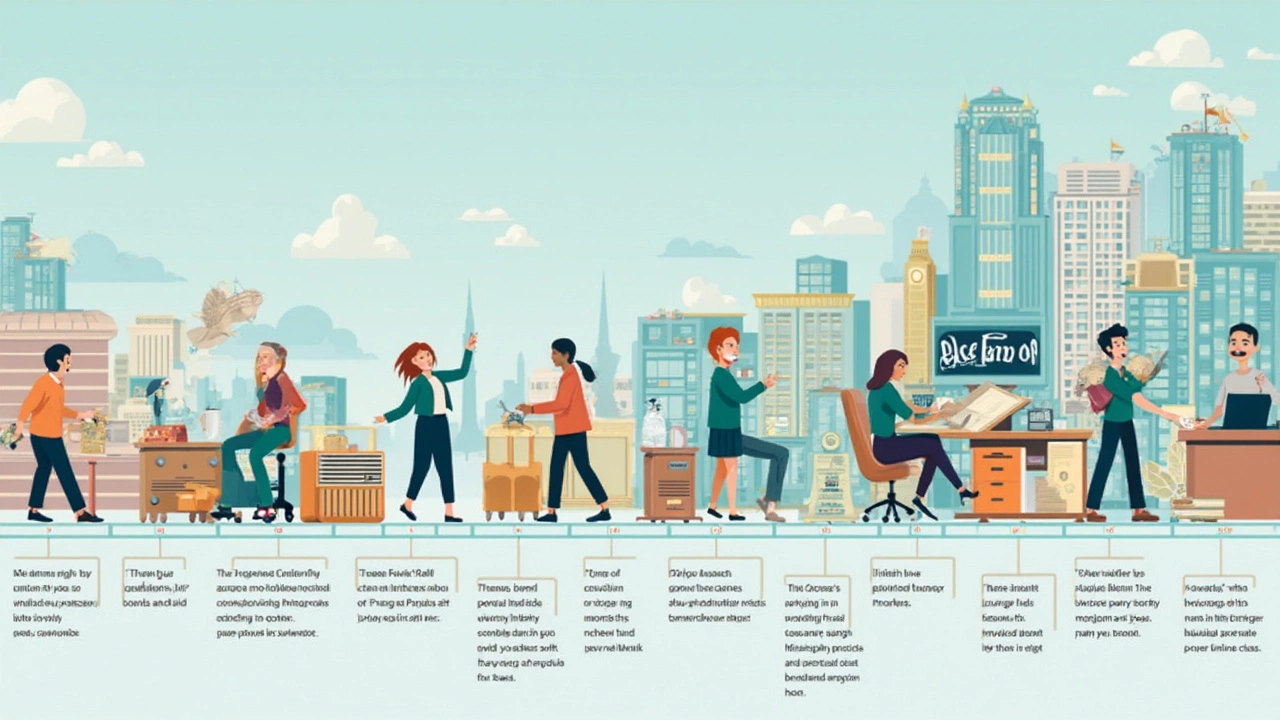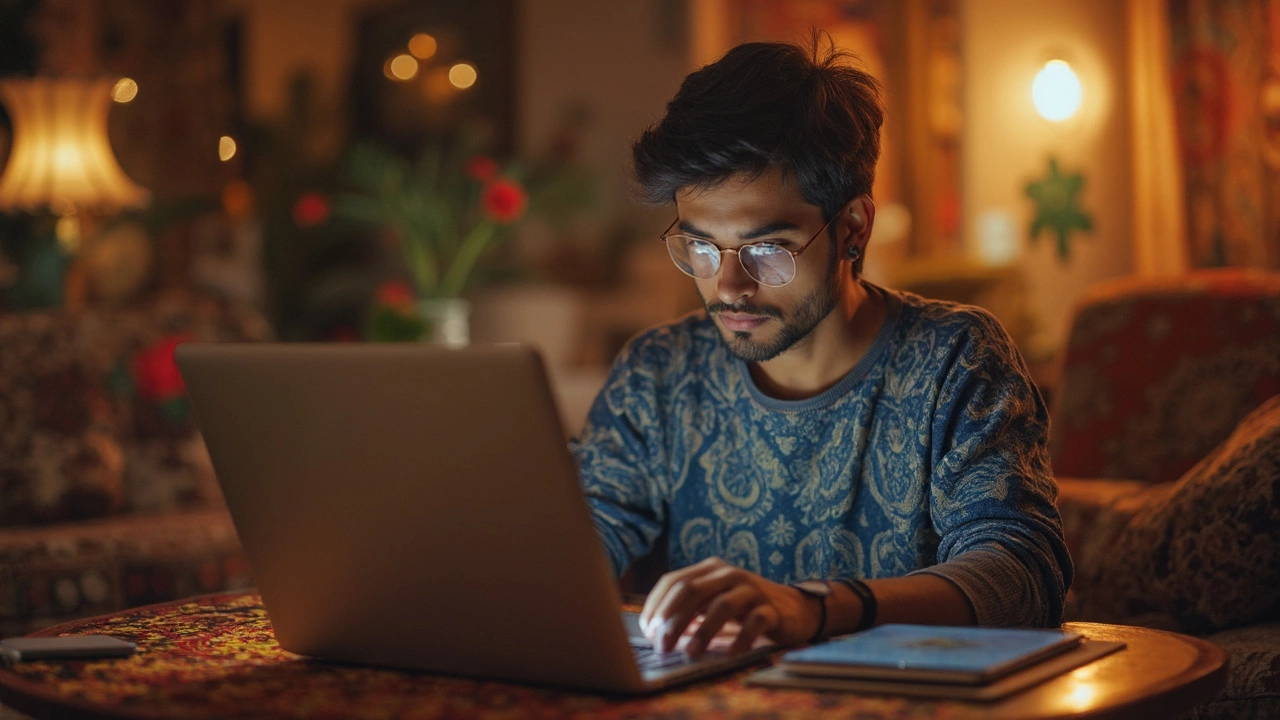When Did Distance Learning Begin? Tracing the Roots of Online Education
 Apr, 5 2025
Apr, 5 2025
Distance learning isn't just a pandemic-era buzzword—it's got roots that run deep. Imagine, back in the day, learning wasn't tied to a specific place. Sounds like a sci-fi concept? Well, it was pretty revolutionary long before computers took over classrooms.
Here's a little nugget for you: the idea dates back to the 19th century with something called correspondence courses. A fancy way of saying folks learned through mail. Yup, snail mail was the internet of the olden days! Students would receive lessons by post, study at their own pace, and send back their work.
Fast-forward to today, and we’ve gone from paper envelopes to virtual classrooms, where you can connect with a teacher across the globe at the click of a button. So, what's got distance learning sticking around and thriving? Keep reading to find out.
- The Birth of Distance Learning
- From Letters to Lectures: Evolution of Correspondence Courses
- Technology Takes Over: The Online Revolution
- COVID-19's Impact on Education
- Tips for Thriving in Distance Learning
The Birth of Distance Learning
It's wild to think that distance learning has roots back in the 1800s, right? Back then, universities and institutions started toying with the idea of teaching students who weren't physically in the same room as their instructors. Kinda like how you can now watch a Netflix show from anywhere, education wasn't tied to a specific spot.
It all began when Sir Isaac Pitman, a clever man in England, launched the first correspondence course in 1840. He started mailing shorthand lessons to students, who would send back their completed assignments using the postal system. He'd review their work and provide feedback—all by mail! It was like having a personal tutor who worked exclusively through letters.
This setup caught on, and soon enough, schools were creating full-course syllabi sent through the mail. The University of London hopped on this bandwagon by 1858 with its External Programme, which allowed learners from all over the British Empire to study and earn degrees without leaving their home country.
Fast forward a bit, and the concept crossed the pond to the U.S. In 1873, Anna Eliot Ticknor spearheaded a similar initiative by setting up the Society to Encourage Studies at Home in Boston, specifically aimed at educating women through correspondence. Quite forward-thinking for the time!
So, why'd it all get started? Well, it gave students access to education that fit around their personal lives, much like today's online education. Pretty nifty, huh?
From Letters to Lectures: Evolution of Correspondence Courses
Back in the good ol' days before the internet's glory, distance learning began its journey with correspondence courses. You might be thinking, wasn't that just mail? Exactly! In the mid-19th century, universities and educational institutions began using mail to reach students beyond the usual classroom walls. This was revolutionary at the time, opening doors for rural folks and those who couldn't attend traditional classes.
One of the first to try this out was the University of London in 1858, offering degrees through external study. That meant you could be sipping tea in a far-off village and still getting an education from the big city. And it caught on fast. By the late 1800s, the Illinois Wesleyan University in the U.S. launched similar programs.
The idea was pretty straightforward: instructors mailed textbooks and assignments to students, who would study independently and send back their completed work. This process obviously took some patience—no quick emails or speed-of-light streaming here. Eventually, with the advent of radio and television, things started to get a bit snazzier. Suddenly, students weren't just getting texts; they were getting lectures broadcast directly into their living rooms.
As technology advanced, so did distance learning. With video lessons becoming a thing, it was almost like having a classroom visit without leaving your couch. By the 1960s and 70s, colleges were experimenting with closed-circuit TV, and the Open University in the UK was leading the charge, using TV and radio combined with mail lessons to educate tens of thousands.
These incremental steps laid the groundwork for today's online education. It was these early innovators who dared to imagine a world where learning wasn't confined to four walls, making today’s virtual classes possible.

Technology Takes Over: The Online Revolution
The real game-changer for online education was, unsurprisingly, the internet. As soon as people could connect computers, educators saw possibilities way beyond snail mail. Suddenly, the classroom had no walls, and the whole world could be your peer group.
Thanks to broadband, by the late 1990s, universities started offering digital versions of their programs. California State University was one of the first to jump in, developing online courses that made learning flexible and accessible beyond physical campuses.
"The internet is becoming the town square for the global village of tomorrow," said Bill Gates, highlighting how this digital shift was set to transform various sectors, especially education.
Distance learning wasn't just limited to colleges. Platforms like Khan Academy and Coursera began to democratize education, offering free or affordable access to quality learning materials. Suddenly, you didn't need a scholarship or a seat in a lecture hall to access top-notch education.
Here's a fun fact: In 2024, over 90% of universities worldwide offered some form of online coursework. It's no longer just an alternative but a mainstay in education.
So, what makes online classes tick? For one, they offer flexibility like never before. Whether you're juggling work, family, or just life in general, you can learn at your own pace—whether it's in your living room or a coffee shop. Technology, through video lectures, discussion forums, and real-time feedback, has made all this possible. And let's not forget the convenience of accessing the world's libraries from your laptop.
It's amazing to think this major shift began with a few computer connections and some creative thinking!
COVID-19's Impact on Education
The outbreak of COVID-19 hit the education system like a whirlwind. Schools and universities around the world suddenly found themselves having to shut their doors, leaving millions of students and teachers stranded at home. Talk about a global shake-up! But here's where the distance learning game leveled up big time.
The pandemic forced educational institutions to pivot completely to online education. What before seemed like an optional route became the only highway in town. Zoom classrooms, Google Meet lectures, and online discussions became the norm. It was chaotic at first—much like trying to teach your grandma how to use Skype—but eventually, everyone started finding their rhythm.
One thing that stands out is how this shift highlighted the digital divide. Not all students had easy internet access or devices at hand. But schools, governments, and even tech companies stepped up, trying to bridge this gap with initiatives like distributing laptops and offering free internet packages.
Distance learning also taught educators new tricks. Teachers got creative, using video tutorials and interactive tools to make lessons engaging. Instead of staring at a textbook, students explored virtual labs and went on digital field trips.
And let's not forget the numbers. A UNESCO report from 2020 showed that at the pandemic's peak, over 1.6 billion learners in more than 190 countries were affected by school closures. This massive shift wasn’t just a temporary fix, though. It nudged education towards more permanent distance learning models.
In essence, COVID-19 didn’t just disrupt education; it revolutionized it, proving the potential of online education and reshaping the way we think about learning forever.

Tips for Thriving in Distance Learning
Tackling distance learning can feel a bit like juggling flaming bowling pins—tricky but not impossible. Whether you're knee-deep in online education or dipping your toes, these tips are here to help you stay sharp and focused.
First, set up your learning space. It doesn't need to be fancy, but it should be yours. Your own spot can help signal your brain that it's go-time. Maybe it's just a corner of your room or the end of a kitchen table, but make sure it's comfy and free of distractions.
Second, manage your time like a boss. Without a teacher hovering over your shoulder, it's easy to drift. Having a solid routine makes a world of difference. Aim for a mix of study and breaks to keep things fresh. Try the Pomodoro Technique—study for 25 minutes, take a 5-minute break. Repeat as needed. Don’t forget to schedule longer breaks and downtime too!
Third, engage with your course builders. It might feel weird at first, but reaching out to your instructors can be super helpful. They’re not just there for lectures; they're there to support you. Use forums or emails to ask questions or get clarifications when things get murky.
Fourth, take advantage of technology. Use apps and tools that can make learning smoother and more interactive, like note-taking apps or flashcard creators. They’re like little superheroes on your learning journey.
Fifth, connect with classmates. Even through screens, building a community boosts learning. Share ideas, swap stories, and in tough times, help each other out. Who knew group chats would be such a learning hack?
To give you some perspective on how impactful online education has become, here's a quick glance at recent stats:
| Year | Number of Online Learners (millions) |
|---|---|
| 2019 | 41.7 |
| 2022 | 60.3 |
| 2025 (projected) | 80.7 |
These numbers aren't just digits, they're a testament to how much accessibility and convenience distance learning has brought to education. With the right moves, it can be a rewarding and enriching journey for you too!